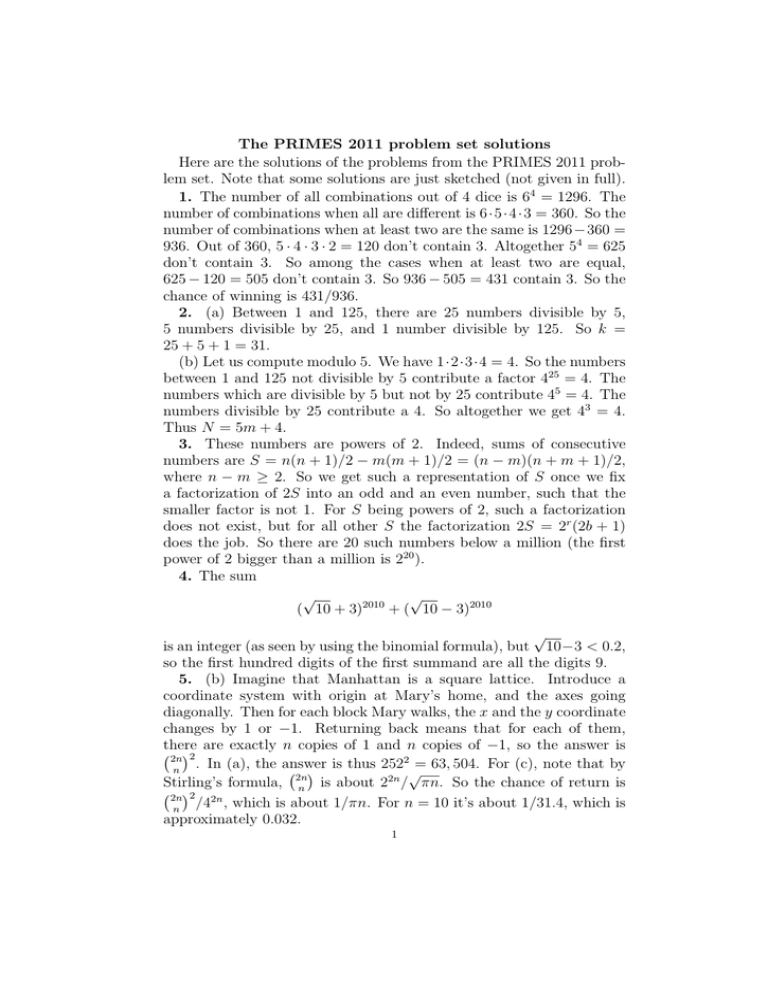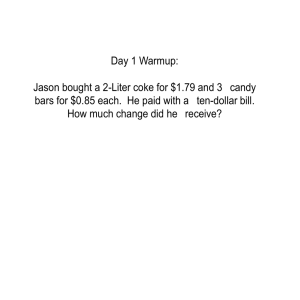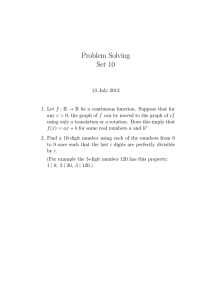The PRIMES 2011 problem set solutions
advertisement

The PRIMES 2011 problem set solutions Here are the solutions of the problems from the PRIMES 2011 problem set. Note that some solutions are just sketched (not given in full). 1. The number of all combinations out of 4 dice is 64 = 1296. The number of combinations when all are different is 6·5·4·3 = 360. So the number of combinations when at least two are the same is 1296−360 = 936. Out of 360, 5 · 4 · 3 · 2 = 120 don’t contain 3. Altogether 54 = 625 don’t contain 3. So among the cases when at least two are equal, 625 − 120 = 505 don’t contain 3. So 936 − 505 = 431 contain 3. So the chance of winning is 431/936. 2. (a) Between 1 and 125, there are 25 numbers divisible by 5, 5 numbers divisible by 25, and 1 number divisible by 125. So k = 25 + 5 + 1 = 31. (b) Let us compute modulo 5. We have 1·2·3·4 = 4. So the numbers between 1 and 125 not divisible by 5 contribute a factor 425 = 4. The numbers which are divisible by 5 but not by 25 contribute 45 = 4. The numbers divisible by 25 contribute a 4. So altogether we get 43 = 4. Thus N = 5m + 4. 3. These numbers are powers of 2. Indeed, sums of consecutive numbers are S = n(n + 1)/2 − m(m + 1)/2 = (n − m)(n + m + 1)/2, where n − m ≥ 2. So we get such a representation of S once we fix a factorization of 2S into an odd and an even number, such that the smaller factor is not 1. For S being powers of 2, such a factorization does not exist, but for all other S the factorization 2S = 2r (2b + 1) does the job. So there are 20 such numbers below a million (the first power of 2 bigger than a million is 220 ). 4. The sum √ √ ( 10 + 3)2010 + ( 10 − 3)2010 √ is an integer (as seen by using the binomial formula), but 10−3 < 0.2, so the first hundred digits of the first summand are all the digits 9. 5. (b) Imagine that Manhattan is a square lattice. Introduce a coordinate system with origin at Mary’s home, and the axes going diagonally. Then for each block Mary walks, the x and the y coordinate changes by 1 or −1. Returning back means that for each of them, there are exactly n copies of 1 and n copies of −1, so the answer is 2n 2 . In (a), the answer is thus 2522 = 63, 504. For (c), note that by n √ Stirling’s formula, 2n is about 22n / πn. So the chance of return is n 2n 2n 2 /4 , which is about 1/πn. For n = 10 it’s about 1/31.4, which is n approximately 0.032. 1 6. The area of a triangle with integer coordinates is a half-integer, so the area S of the triangle T is rational. If the sides of√the triangle are 2a, 3a, 4a then by Heron’s formula its area is 43 a2 15. So √ a2 = 4S/3 15, i.e. is irrational. This is a contradiction, since by the Pythagorean theorem a2 has to be a rational number. 7. Let pn be the probability of the population to die out by the n-th generation (where we begin with the zeroth generation). Then p1 = p, p2 = p2 (1 − p) + p, and in general pn+1 = p2n (1 − p) + p. The sequence pn by definition is increasing, so it has a limit q. Thus, p q = q 2 (1 − p) + p, so q = 1−p , or q = 1. If p ≥ 1/2 then the first solution makes no sense (as we must have q ≤ 1), so q = 1, and thus the probability of the population to survive indefinitely is 1 − q = 0. p p If p ≤ 1/2 then pn ≤ 1−p for all n (as pn+1 ≥ pn ), so q = 1−p , and the 1−2p indefinite survival probability is 1 − q = 1−p . 8. For twins the probability of a healthy descendant is (1 − 41 × 12 × 1 8000 ) , which is about 0.37. So the probability of disease is about 103 63%. For unrelated parents, the probability of a healthy descendant is (1 − 14 × 1/106 )8000 , which is about 0.998, so the probability of disease is 0.2%. 9. We have (2m + 1)2 − 1 = 4m(m + 1), which is divisible by 8. So any number with required property is of the form 8k + 1. Conversely, we claim that any number of the form 8k + 1 is the remainder mod 2n of a perfect square. We prove it by induction in n starting n = 3. The base is clear, so we make an induction step from n − 1 to n for n ≥ 4. Let a be an odd number between 1 and 2n . By the induction assumption there exists x such that x2 − a is divisible by 2n−1 . If it is not divisible by 2n , then it gives remainder 2n−1 when divided by 2n . Now, (x + 2n−2 )2 − a = x2 − a + 2n−1 + 22n−4 . The last summand is divisible by 2n as n ≥ 4, so (x + 2n−2 )2 − a is divisible by 2n , as desired. 10. (a) We have an = 2n for n = 0, ..., k−1. If n ≥ k then a sequence satisfying our condition ends with a 1, or with 10, or with 100, or with 100..0 (k − 1 zeros). So an = an−1 + ... + an−k . (b) By (a) the first values of an (3) are: 1, 2, 4, 7, 13, 24, 44, 81, 149, 274, 504. So a10 (3) = 504. (c) The characteristic equation of the recursion is tk = tk−1 + ... + 1. 2 This equation has a unique positive solution 1 < T < 2, which is a simple root, as seen by setting t = 1/x (this gives 1 = x + x2 + ... + xn ). Moreover, for any complex root z of the equation, one has |z| < T (as again is seen by setting t = 1/x). This implies that the general solution of the recursion is of the form yn = CT n + εn , where εn /T n goes to 0. It remains to show that in our case C > 0. To see this, it suffices to note that for any solution yn of the recursion, there is a constant M such that |yn | ≤ M an . Thus, an ∼ = CT n and pn ∼ = C(T /2)n . So b = T /2 and thus b < 1 (d) For k = 2, an (2) is the Fibonacci sequence, and T 2 = T + 1, so √ T is the golden ratio, and b2 = 5+1 . 4 11. (a) Assume the contrary, and let V be a 2-dimensional space with the required property. Let A, B ∈ V be non-proportional. Then det(At + B) is a polynomial of degree n. This degree is odd, so f has a real root. For this root t, At + B is not invertible, a contradiction. (b) Pick V ⊂ M (r) of dimension f (r) and take V 0 ⊂ M (rs) consisting of A ⊕ ... ⊕ A (s times), A ∈ V . (c) If V ⊂ M (n) is an n + 1-dimensional space, then it has a nonzero element with zero first row. (d) f (2) = 2 (V =complex numbers). (e) f (4) = 4 (V =quaternions). (f) f (8) = 8 (V =octonions). (g) For C, f (n) = 1 for all n, since det(At + B) always has a root (similar to (a)). For Q, f (n) = n; indeed, f (n) ≤ n by (c), and for ndimensional V we can take Q(21/n ) acting on itself by left multiplication (in some basis, e.g. 2j/n , j = 0, ..., n − 1). 12. (a) The sequence is decreasing, so has a limit x such that x = x − xm+1 , so x = 0. (b,c) Compare the sequence xn to yn = Cn−b , b > 0, C > 0. The sequence yn satisfies the recursion yn+1 = C((yn /C)−1/b + 1)−b , or yn = yn − bC −1/b yn1+1/b + ... (1 + (yn /C)1/b )b So one should expect that 1 + 1/a = m + 1, or a = m1 . Also, one should expect that K −m /m = 1, so K = m−1/m . To prove that this is indeed the case for a, let us write yn as yn (b, C) and squeeze the sequence xn between two (possibly shifted) sequences of the form yn (a1 , C1 ) and yn (a2 , C2 ) for any a1 < m1 < a2 . Once this is done, we similarly squeeze yn+1 = 3 xn between two (possibly shifted) sequences yn (a, C1 ) and yn (a, C2 ) for any C1 < m−1/m < C2 , proving (c). 4






